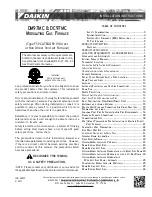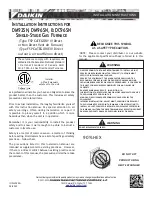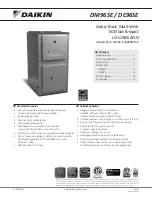
MF47-3.05
8
4.0
M
AINTENANCE
4.1
Routine Maintenance
Preventive rather than reactive maintenance is to be preferred. The type and frequency depends on
furnace use: the following are recommended.
4.1.1
Cleaning
The furnace outer surface may be cleaned with a damp cloth. Do not allow water to enter the
interior of the case or chamber. Do not clean with organic solvents.
4.1.2
Safety Switch
The door switch operation mentioned in 3.2 should be checked periodically to ensure that heating
elements are isolated when the door is opened. In normal conditions the safety arrangement should
outlast the furnace, but it could be affected by rough handling, a corrosive environment or work
materials, or exceptional frequency of use. The frequency of checking depends on furnace use: if in
doubt, make the check.
A qualified electrician should check that the supply to the heating elements is cut, with and
without power being on, when the door is open partially and fully; it is important that isolation is
not just marginally achieved. The check should be made on the element ends or braids after
removal of the case top. Note that both live supply wires of a 2-phase supply, and both live and
neutral of a 1-phase supply, should be isolated when the door is opened.
4.1.3
Other Electrical Components
Regular visual or electrical checks should be made on the condition of the supply cable, and all
internal fuses and visible internal cables should be inspected periodically.
4.1.4
Element Glaze
Depending on use the heating elements may lose their glaze and gain a rough appearance. They
should be checked from time to time. If the glaze has gone, it may be restored by heating the
furnace up to 1500°C without load, for 2 hours or so.
4.2
Calibration
After prolonged use the controller and/or thermocouple could require recalibration; see the
warning about 1700-1800°C thermocouples in section 3.11. This would be important for processes
which require accurate temperature readings or which use the furnace close to its maximum
temperature. A quick check using an independent thermocouple and temperature indicator should
be made from time to time to determine whether full calibration is required. Carbolite can supply
these items.
Depending on the controller, the controller manual may contain calibration instructions.
4.3
After Sales Service
Carbolite’s service division (Carbolite Engineering Services) has a team of Service Engineers
capable of repair, calibration and preventive maintenance of furnace and oven products at our
customers’ premises throughout the world. We also sell spares by mail order. A telephone call or
fax often enables a fault to be diagnosed and the necessary spare part despatched.
Each furnace has its own record card at Carbolite. In all correspondence please quote the serial
number, model type and voltage given on the rating label of the furnace. The serial number and
model type are also given on the front of this booklet when supplied with a furnace.
To contact Carbolite Engineering Services or Carbolite see the back page of this manual.
4.4
Recommended Spares Kits
Carbolite can supply individual spares, or a kit of the items most likely to be required. Ordering a
kit in advance can save time in the event of a breakdown. Each kit comprises one thermocouple,
one sheath, one power thyristor, one door insulation piece, and a set of elements, clips and braids.






































